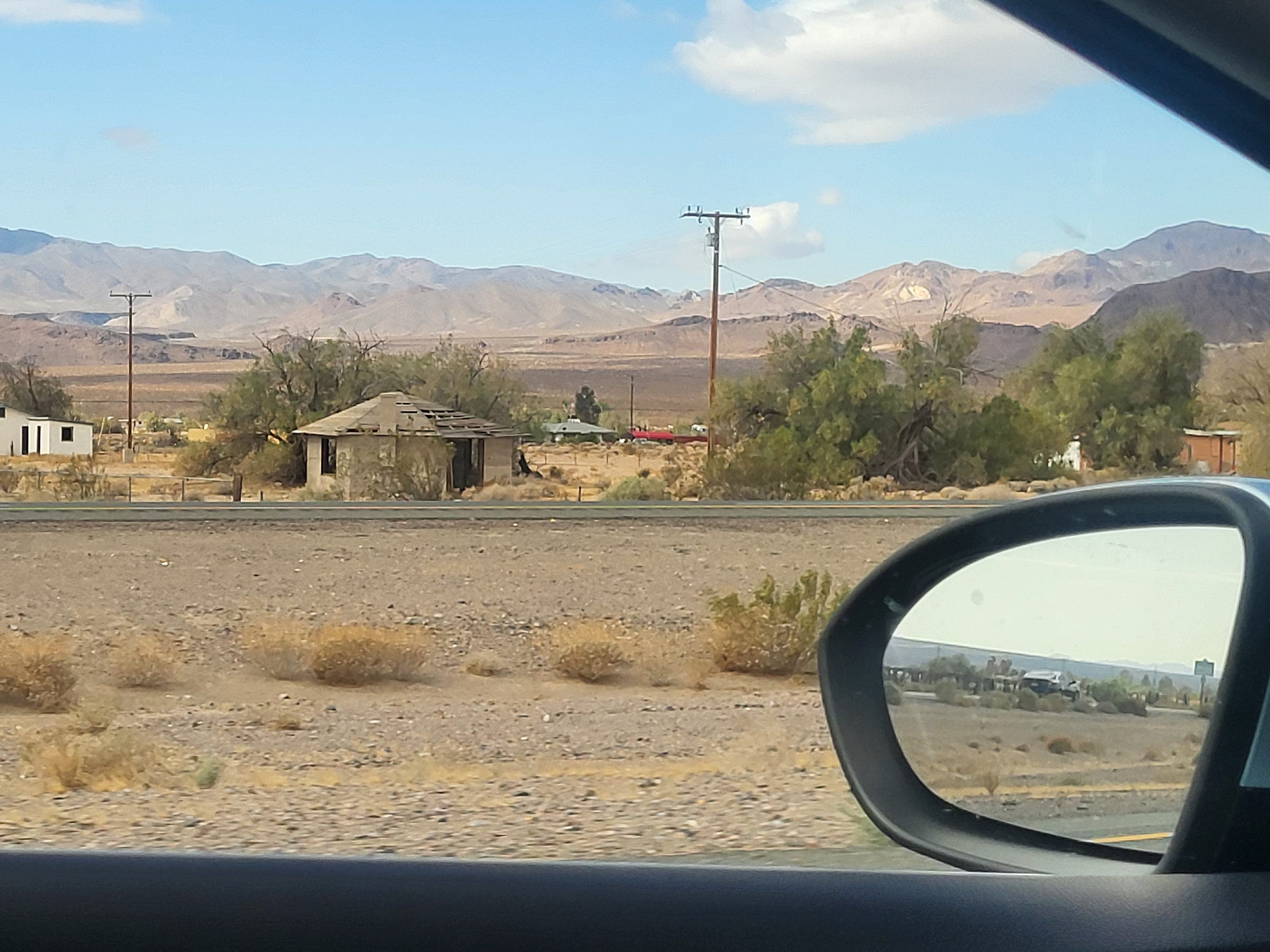
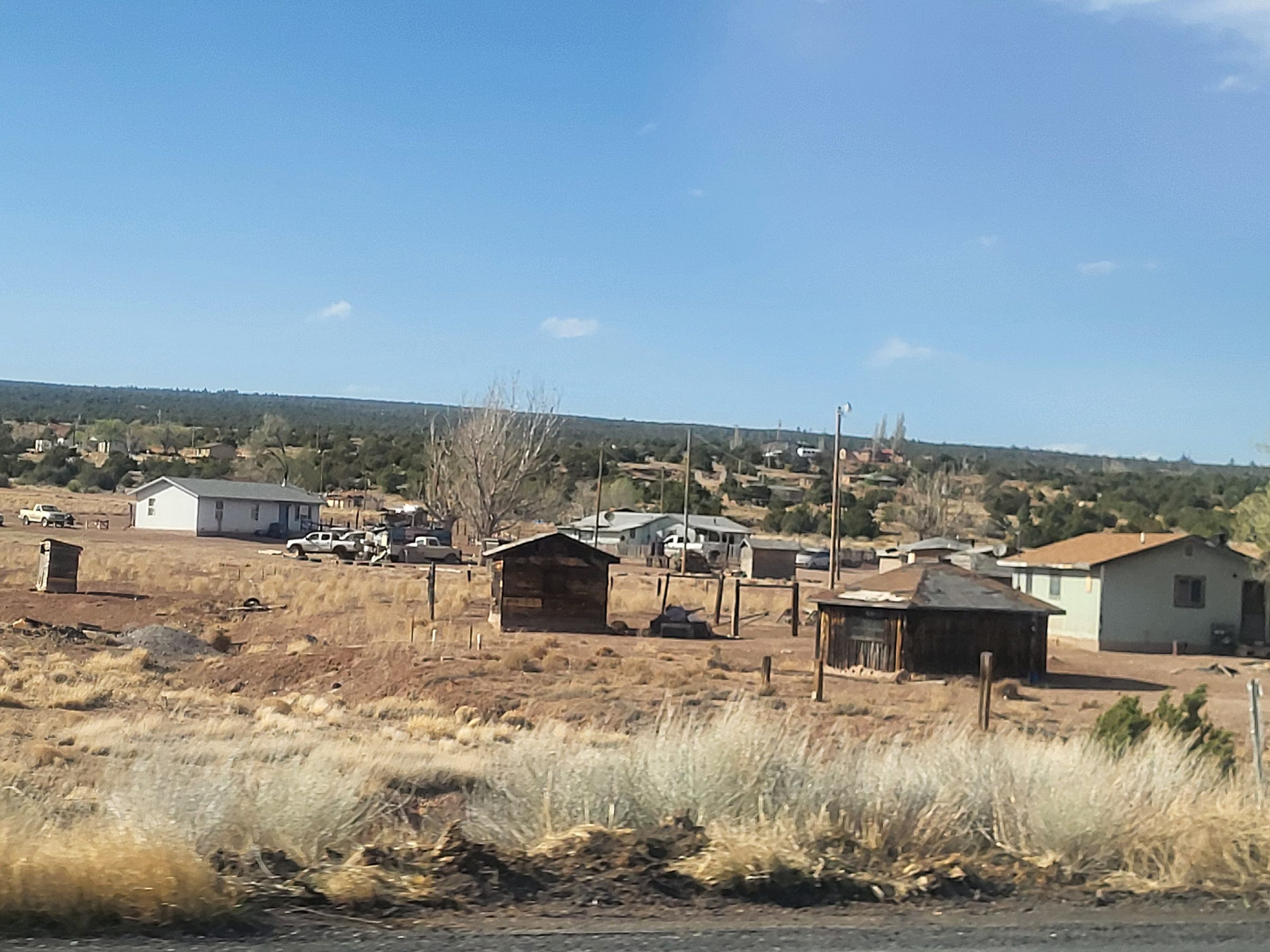
A shattered hogan decays under an uncaring sky along I-40, just outside Flagstaff or Kingman, Arizona, its splintered beams a tombstone for tribal traditions on Navajo land. The desert sprawls around it, a desolate expanse of dry grass and forgotten dreams, dotted with rusted trailers and sagging homes, all framed by the distant, indifferent silhouette of mountains. Decades ago, this stretch pulsed with life: a tribal truck stop where truckers swapped tales over frybread, locals sold silver jewelry, and kids darted through the pumps, their laughter a fleeting defiance of the dust. Now it’s a husk, the neon long extinguished, the fuel islands silent, a relic of a world slipping away—not just here, but everywhere, as humanity stumbles through a change of eras.
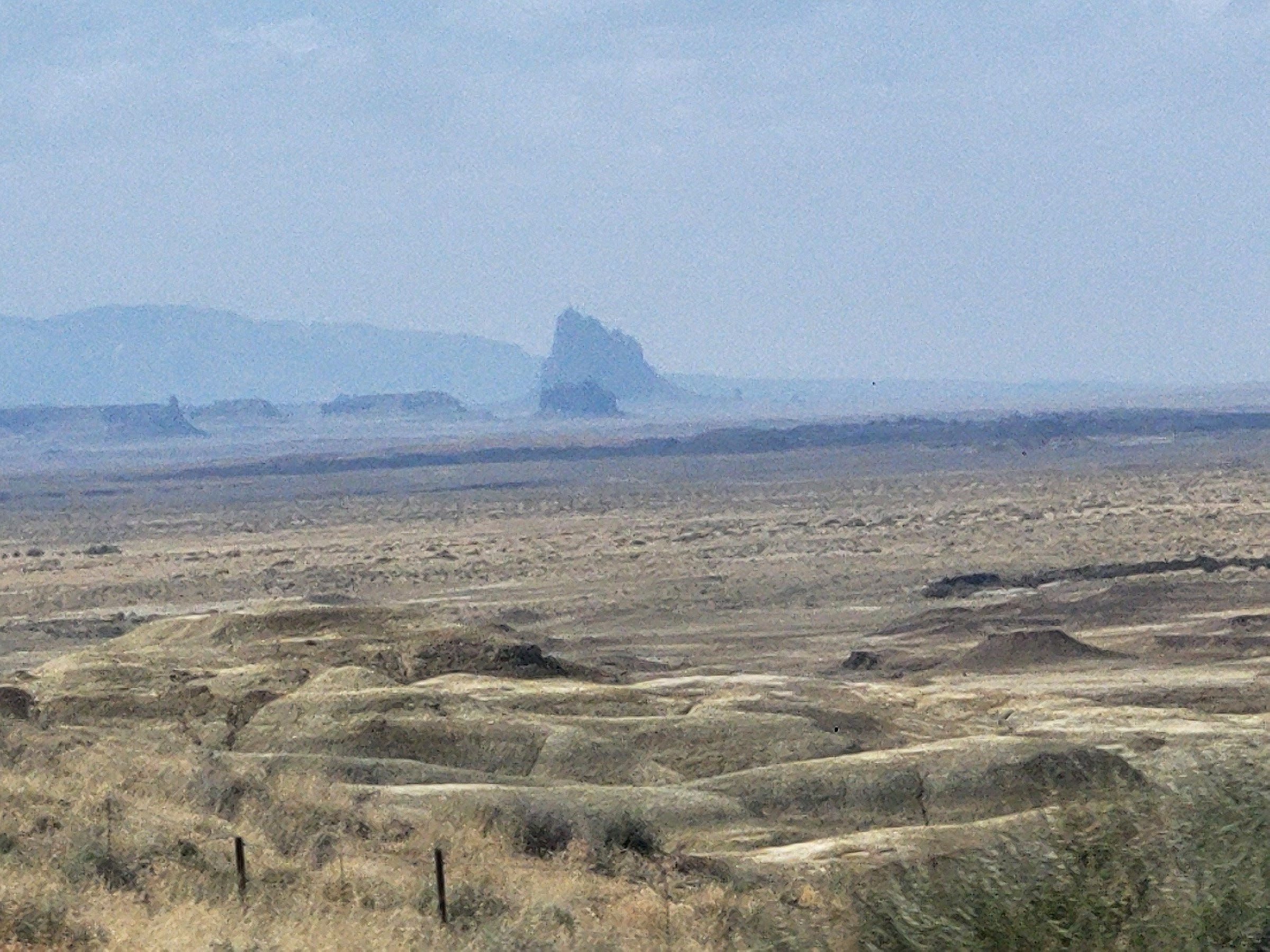
Compass Star Wordsmith is a reader-supported publication, fanning the phoenix flames of stories like Shiprock’s rise. To receive new posts and fuel this journey, let’s smoke the peace pipe of support—click the blue button in the purple haze for a subscription sweeter than a kitschy dream-catcher souvenir from a Navajo roadside stall, and become a free or paid subscriber today!
This isn’t mere change; it’s a tectonic shift, a rupturing of the very bedrock of human existence across every facet of life. Culturally, the threads that once wove communities together unravel—here on the reservation, the sacred hogans crumble, their ceremonial hearths cold, while in the wider world, mainstream religions hemorrhage youth to the glow of screens, leaving hollowed-out faiths in their wake. Politically, the old order fractures, with populist waves of 2025 clashing against entrenched powers, both federal and tribal, as corruption and neglect choke progress. Spiritually, the loss of tribal traditions mirrors a broader societal drift, where meaning is traded for distraction, and the compass of purpose spins wildly. Professionally, the ground shifts beneath workers’ feet—truckers, artisans, and small-business owners on I-40 watch their livelihoods erode, just as factory workers and clerks elsewhere face the same relentless tide of automation. This change of eras spares no one, reshaping how we live, believe, and survive.
The roots of this collapse on the reservation stretch back three decades, a slow bleed of vitality that mirrors the world’s own unraveling. The Navajo Nation has watched its heartbeat falter as youth flee to cities like Phoenix, escaping failing schools with dropout rates above 30% and the scourge of methamphetamine, which SAMHSA reports runs at double the national average here. Governance offers no reprieve—federal policies break promises on healthcare and infrastructure, while tribal leadership, mired in corruption, fails its people. Economic viability has collapsed, with unemployment exceeding 50%, per the Bureau of Indian Affairs, leaving small businesses like the truck stop to wither. Each thread—youth flight, bad governance, addiction, failing education, economic ruin—has woven a tapestry of despair, a microcosm of a society adrift, searching for direction in a world that no longer fits.
At the heart of this erosion stands the hogan, a traditional Navajo home now reduced to a broken shell, its splintered walls and caved roof a stark symbol of what’s been lost. For tribal elders, hogans were the soul of daily life—octagonal sanctuaries where families gathered, ceremonies unfolded, and stories were etched into the smoke of cedar fires. Now, they’re relics, shunned by a generation chasing modernity over heritage, a rejection that echoes the broader spiritual hollowing of society. Elders still see the hogan as sacred, a tether to the past, but for the youth, it’s a forgotten husk, much like the churches and synagogues abandoned by their own peers. This generational divide cuts deep, a wound that mirrors humanity’s own loss of direction, as we trade the sacred for the fleeting, leaving behind a landscape of shattered meaning.
Yet, in this fractured era, a new path emerges, one carved by the unerring precision of technology—a stark contrast to the messy faltering of human hearts. Driverless trucks, like those from Aurora Innovation, roll through these lands, their cold efficiency a metaphor for progress we can scarcely imagine. They don’t stop, don’t falter, don’t lose their way, unlike us, caught in the chaos of our own making. Drones and 3D-capable vehicles hum above, part of a technological vanguard that promises to reshape these lands and the people who call them home. They offer a way forward—jobs, connectivity, a new kind of lifeline—not to restore the hogans or the truck stops, but to build something new on the ashes of what was. In this change of eras, they are a beacon, a reminder that while we may stumble, the machines we’ve built might just lead us to a future we can’t yet see.
A Digression: The Unseen Beauty of a Soulless Journey
Beyond the shattered hogans and silent truck stops, the vast desert stretches toward horizons like Shiprock, a lone volcanic sentinel rising 1,583 feet from the Navajo plain. This ancient neck, forged 25-30 million years ago from cooling magma and sculpted by relentless erosion, stands as a testament to time’s indifference—its jagged silhouette piercing a sky that human truckers once watched with awe. They’d pull over, coffee in hand, to marvel at the dikes radiating like frozen lightning, sharing stories of the land’s spirit with a reverence born of hours behind the wheel. Each mile of I-40 offered vistas—red rock canyons, endless plains, the distant Chuska Mountains—etched into their souls, a bond between man and wild that fueled their grit.
Driverless trucks, with their unblinking sensors and pre-programmed routes, will pass these wonders without a glance. Their algorithms don’t pause for beauty, don’t feel the weight of a landscape shaped by tectonic upheavals and wind-carved badlands. Shiprock, a geological poem of volcanic breccia and minette, will be reduced to a data point—coordinates to navigate, not a story to tell. The hum of drones overhead, the whir of 3D-capable vehicles, will skim this earth without ever knowing its pulse, their soulless efficiency blind to the colors of a sunset or the whisper of a storm on the horizon. This land, once a companion to the human spirit, becomes a mere corridor for machines.
This loss cuts deeper than economics; it’s a tragedy of the human soul. Truckers weren’t just drivers—they were poets of the road, their CB radios alive with tales of Shiprock’s shadow or the eerie glow of a desert moon. Their eyes caught the flicker of a hawk, the shift of sand, the way light danced on eroded cliffs—moments that stitched meaning into the monotony. Driverless rigs, with no heart to break or spirit to lift, erase that connection. The reservation’s decline is mirrored in this mechanized indifference, where the land’s voice goes unheard, its beauty unappreciated by the very technology meant to save us.
As this change of eras unfolds, the cultural, political, familial, spiritual, and professional fabric frays, and with it, the human capacity to see. The truck stop’s ghost lingers not just in its silence but in the lost gaze of those who once drank in these views. Driverless trucks promise progress—unerring, efficient, forward-moving—but they offer no solace, no wonder. They are a metaphor for a humanity that risks losing itself, trading the messy, soulful journey for a sterile path, where Shiprock stands alone, unseen, a monument to a world we’re leaving behind.
Yet, in this tragedy lies a challenge. If we let machines define our direction, we surrender the very essence that makes us human—the ability to feel the land, to find meaning in its vastness. The technological vanguard—drones, eVTOLs, autonomous rigs—could be more than tools; they could be bridges, if we teach them to honor what we’ve loved. The question remains: will we imbue them with a fragment of our soul, or let them roll on, blind and empty, through a landscape that once spoke to us?
The Skyward Shift: Drones and 3D-Capable Vehicles
As truck stops fade, the sky offers hope. Driverless trucks need hubs—charging stations, maintenance depots, cargo transfer points. Aurora’s Texas hubs, blending human-driven city legs with robotic highways, are the blueprint. But the future lies higher: drone hubs and 3D-capable vehicles like eVTOLs (electric vertical takeoff and landing craft), transforming society from land-bound to aerial. The global drone market, valued at $30 billion in 2024, is projected to hit $42.8 billion by 2025, growing at 13.8% annually, driven by players like DJI, Pix4D, DroneDeploy, and startups like Zipline.
Drones are already reshaping industries. In agriculture, they monitor crops with multispectral sensors, boosting yields while cutting labor, as seen with DJI’s Agras T40. Construction firms use DroneDeploy’s software for 3D mapping, slashing survey costs by 239% yearly growth. Real estate leans on drones for aerial photography, with listings featuring drone shots selling faster. Public safety employs drones for search-and-rescue, using thermal cameras to find missing persons in rugged terrain. Zipline’s delivery drones drop medical supplies in remote areas, hinting at scalable logistics.
This shift demands workers. The FAA reports over 331,570 certified drone pilots by 2023, with demand surging across industries. Pilots need FAA Part 107 certification, testing airspace and safety knowledge, but roles extend beyond flying. Data analysts process aerial imagery, coders develop navigation algorithms, and mechanics maintain fleets. In construction, drone surveyors create 3D models, requiring GIS software skills. Agriculture needs specialists in crop science to interpret drone data. Film and journalism seek pilots with cinematography expertise. Salaries reflect demand: drone operators average $42,748, with specialized roles like surveyors hitting $73,189.
On reservations, drone hubs could be transformative. Vast tribal lands, paired with solar potential, are ideal for solar-powered depots. These hubs need construction crews, techs for drone maintenance, and operators for beyond-visual-line-of-sight (BVLOS) missions. Training programs, like DARTdrones’ courses, could upskill locals, offering paths to FAA certification and jobs. Tribes could lease land for vertiports—drone takeoff/landing pads—generating steady revenue. Unlike truck stops, these hubs won’t revive cultural stalls, but they could fund schools and clinics, anchoring communities. Moreover, this shift highlights the enduring value of trade skills—building, repairing, and maintaining these hubs—standing as vital as brain skills like coding or data analysis, ensuring a balanced renewal of both hands and minds.
The leap to 3D-capable vehicles is bolder. Urban air mobility (UAM), using eVTOLs for air taxis or cargo, is emerging, with Joby Aviation and Archer testing models for urban commutes. These vehicles navigate three-dimensional airspace, bypassing roads and slashing travel times. Amazon’s Prime Air, delivering packages since 2024, shows drones’ last-mile potential. On reservations, eVTOLs could connect remote areas to cities, delivering goods or medical supplies. Building this requires infrastructure—vertiports, charging stations, and UTM (unmanned traffic management) systems—creating jobs for engineers, planners, and operators. By 2030, UAM could add $1.2 trillion to global GDP, with rural areas like reservations poised to benefit if included.
A Vision: Reviving the Spirit of the Stops
But what if drone hubs offered more than revenue—a chance to resurrect the cultural heartbeat of the reservation? Imagine tribes transforming these vertiports into vibrant cultural sanctuaries, where the hum of drones harmonizes with the rhythm of traditional drums. Instead of merely leasing land for economic gain, these hubs could become modern-day gathering places, echoing the spirit of the old I-40 truck stops. Artisans could set up stalls, their turquoise jewelry and woven blankets catching the light as they once did, while elders share stories of Shiprock’s volcanic birth under the shade of solar panels. This isn’t just infrastructure—it’s a reclamation of what was lost, a bridge between past and future.
These cultural hubs could host powwows, their dances weaving through the shadows of charging drones, a testament to resilience in the face of change. Youth, who’ve drifted to cities, might return, drawn by the call of tradition reimagined—learning to craft alongside their elders, their hands shaping clay and silver as their ancestors did, while drones buzz overhead delivering medicine. The laughter of children, once a memory at the fuel pumps, could echo again, chasing each other around vertiports turned communal squares. This vision prioritizes the soul of the community over profit, proving that technology can amplify heritage rather than erase it.
The economic trade-offs are real—such hubs might not fund schools or clinics as directly as leased vertiports could. But the deeper gain lies in the reweaving of cultural threads, the restoration of pride that comes from seeing traditions live again. A vertiport market selling handmade kachina dolls or hosting a Navajo weaving workshop offers more than income—it offers identity, a tether to the past that anchors the present. The reservation’s youth, so often lost to the pull of modernity, might find a reason to stay, their roots rediscovered in the shadow of innovation. This is a different kind of wealth, one measured in stories told and songs sung, not dollars earned.
This vision also challenges the narrative of progress as a soulless march. If drone hubs can become cultural beacons, they might inspire a broader shift—where technology serves the human spirit, not just efficiency. Imagine drone operators trained not only in FAA certification but in the oral histories of their people, their routes over Shiprock a flightpath of reverence as much as logistics. The hum of eVTOLs could carry the echo of a chant, their cargo drops a nod to the communal sharing of old. This is technology with a soul, a chance to heal the wounds of a fractured era by blending the new with the timeless.
Ultimately, this path is a call to dream bigger—to see drone hubs not as sterile outposts but as hearths of renewal. The truck stops of I-40 were more than fuel stops; they were lifelines of culture and connection, places where the human spirit thrived amidst the grind. By reimagining vertiports as cultural sanctuaries, tribes can reclaim that spirit, ensuring that the future doesn’t just rise from the ashes of the past but carries its fire forward. It’s a vision where the ghosts of the last truck stop find new life, their legacy woven into the very fabric of the sky.
The Players and the Populist Fight
The drone industry’s giants—DJI, Pix4D, DroneDeploy—drive innovation, but startups like Zipline and Hylio push boundaries with BVLOS swarms for agriculture and delivery. Aurora’s driverless trucks and Tesla’s Semi, still lagging, hint at Musk’s autonomous ambitions, potentially extending to drones or eVTOLs. Musk’s universal basic income idea feels like a dodge to a Navajo cashier or motel worker; retraining for drone jobs is tougher when millions compete. Aurora’s “fleet monitors” and retraining programs are steps, but scaling to replace 3.5 million drivers is daunting. The populist surge of 2025, demanding real jobs, eyes these companies warily. If they don’t deliver wages over promises, they’ll face a backlash louder than a union rally.
Critically, the drone promise isn’t flawless. FAA regulations lag, with BVLOS rules (Part 108) still pending, limiting scalability. Safety concerns—drones crashing in populated areas—persist, and UTM systems aren’t fully integrated with manned airspace. Reservations face barriers: training costs, internet access, and federal investment are scarce. The cultural loss of truck stops—where stories flowed like coffee—won’t be replaced by sterile hubs. Yet, the potential is real if tribes and workers are prioritized.
The old truck stop’s a memory, its lot fractured like lost dreams. Midwest chrome palaces and Southwest desert havens share its fate. But above, a new hum grows—drones and eVTOLs rising, hubs forming, workers forging a 3D future. It won’t bring back the frybread or turquoise stalls, but it could breathe life into these lands. The question is whether Aurora, DJI, Musk, and the rest will build with the people, or fly past, leaving only ghosts.
check out the trucker playlist! you will have never heard these songs before - correct me if i am correctable!
rise to your best self
Ric




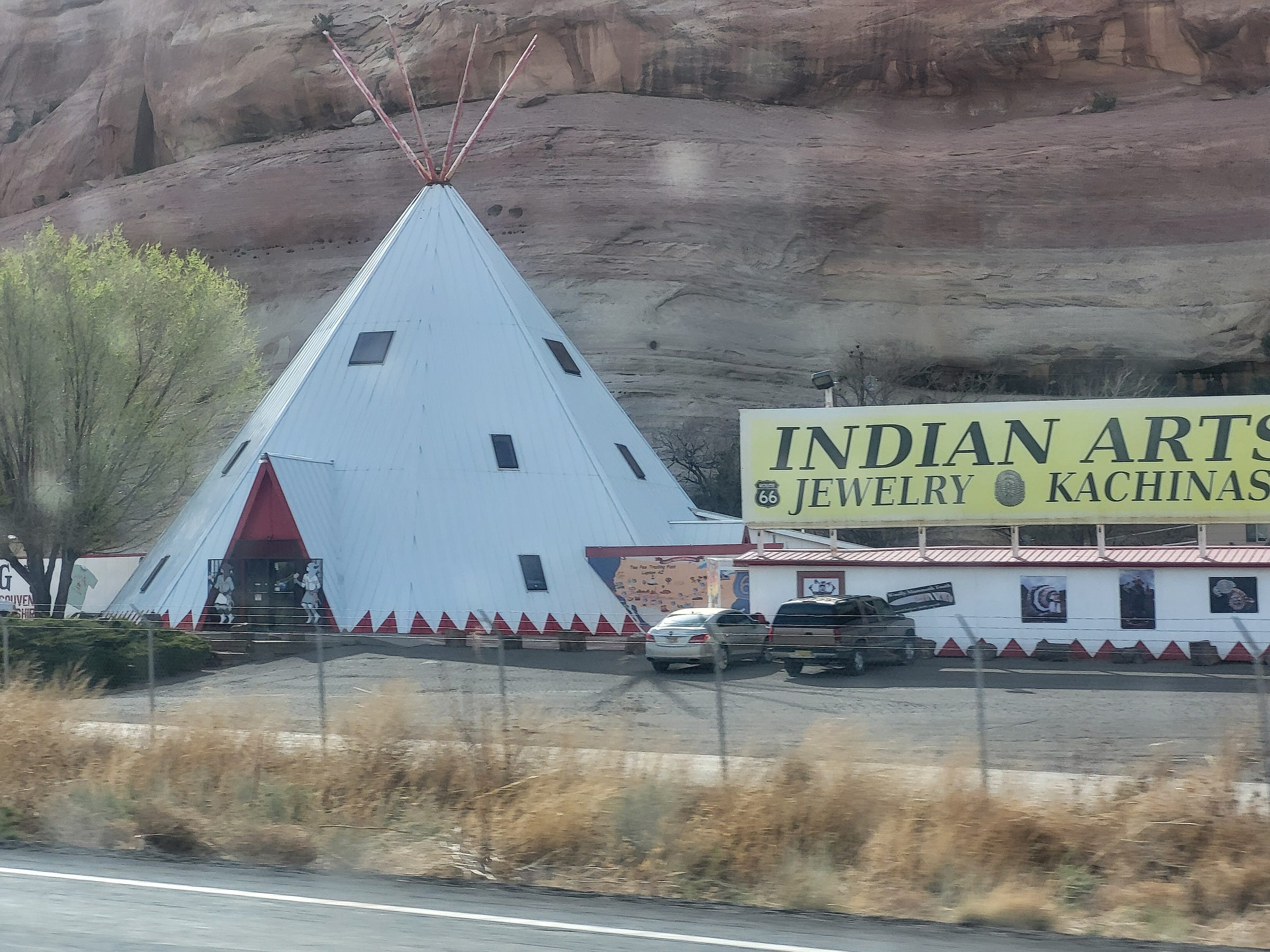
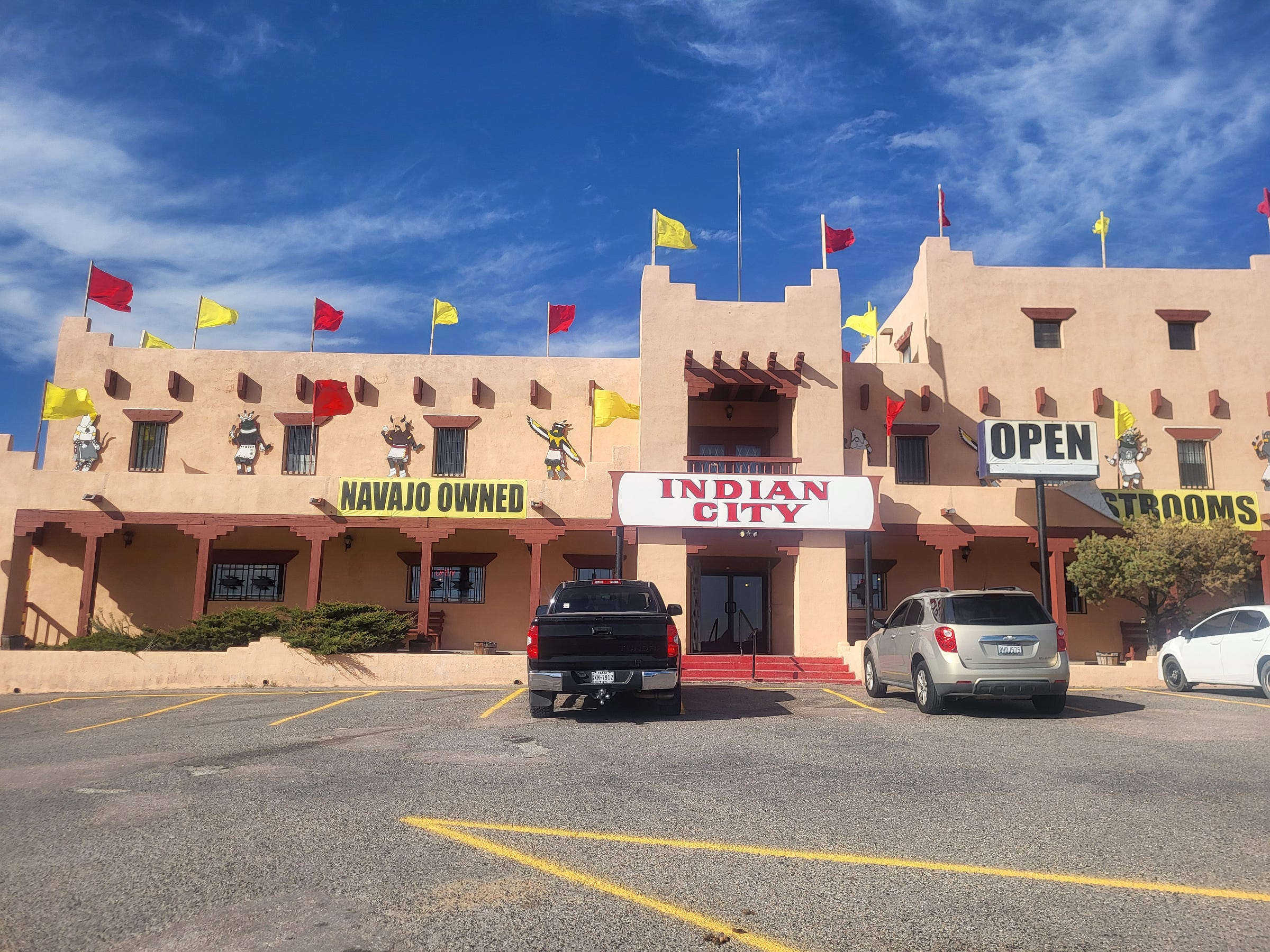
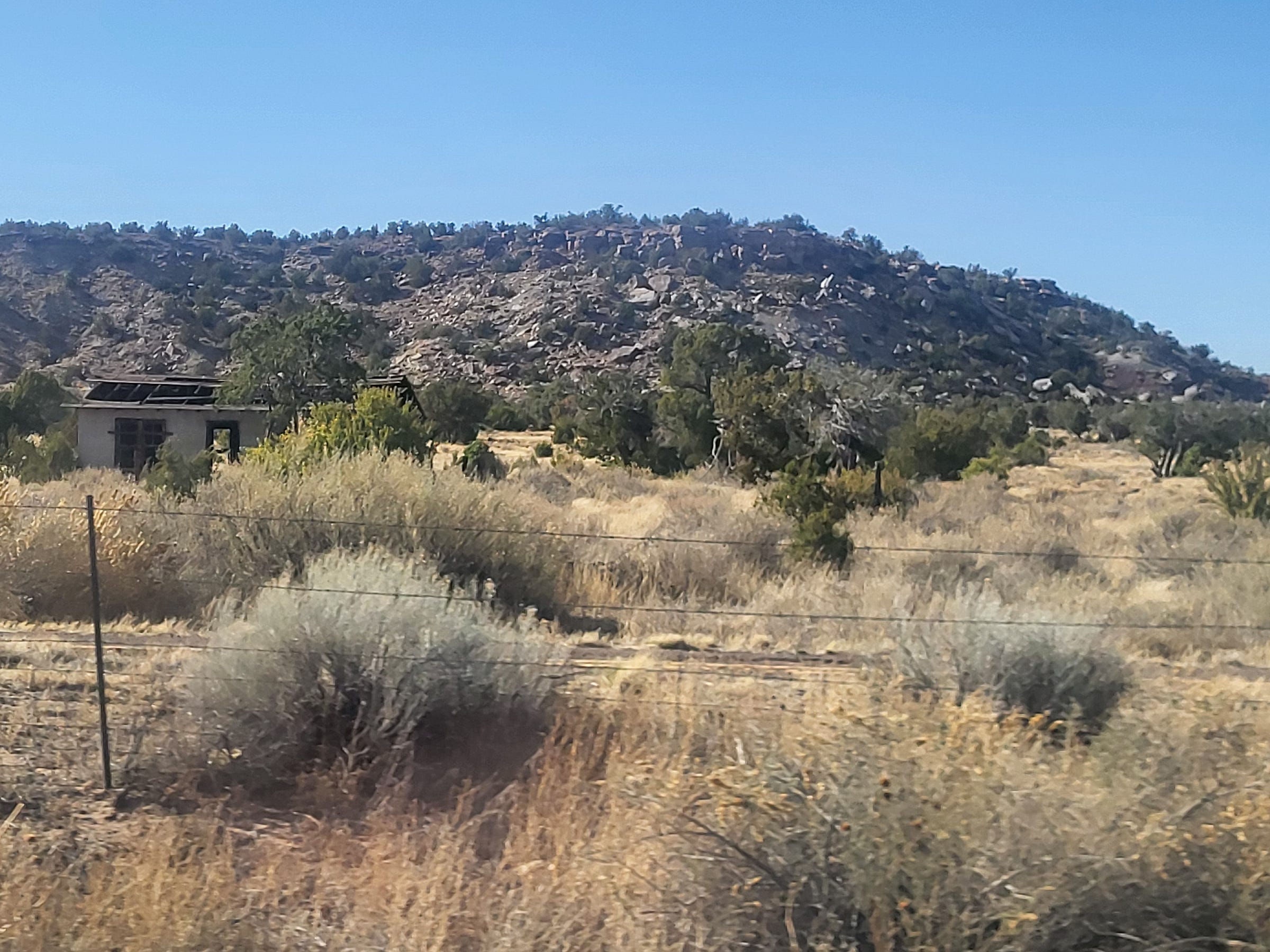
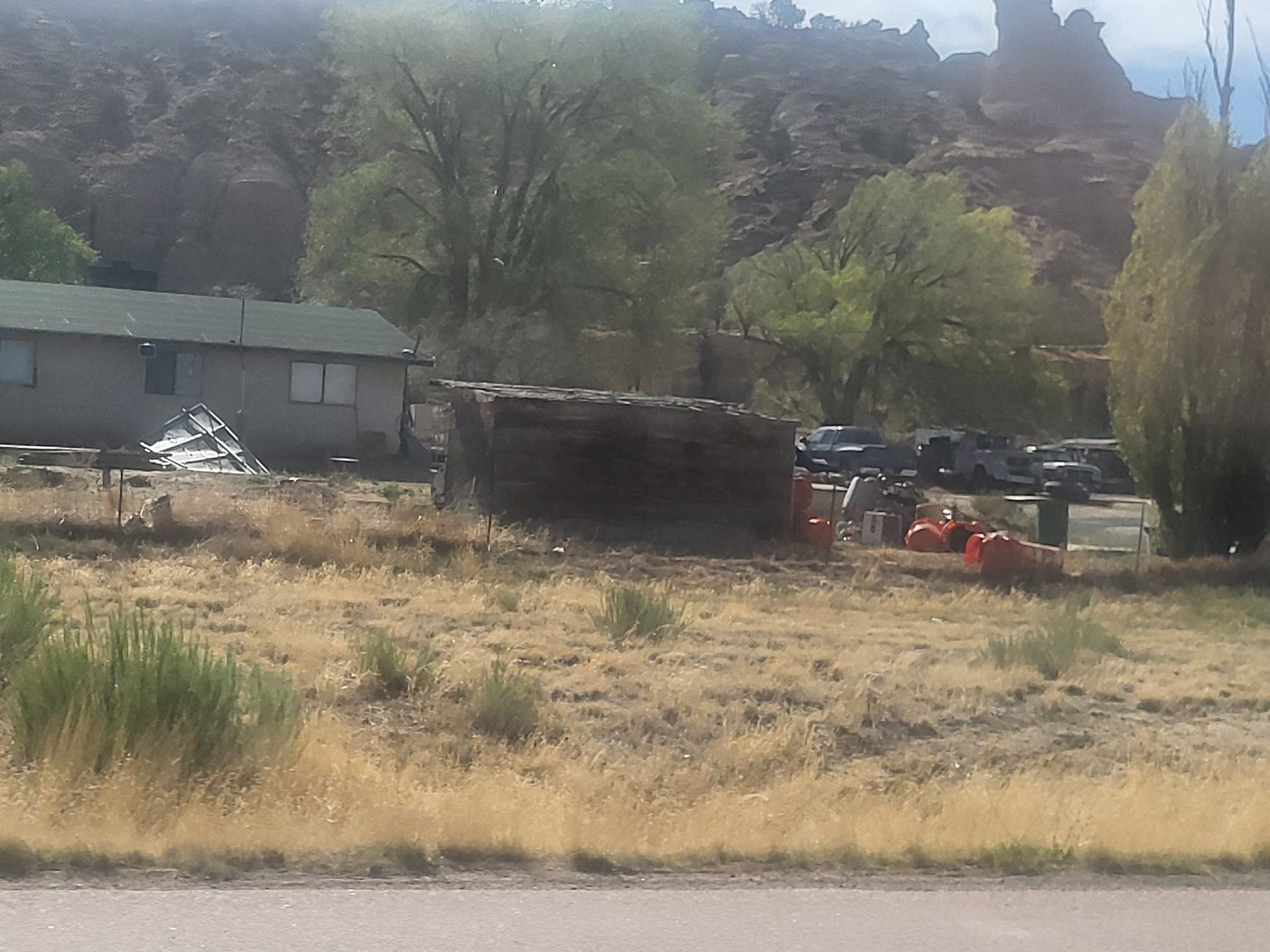


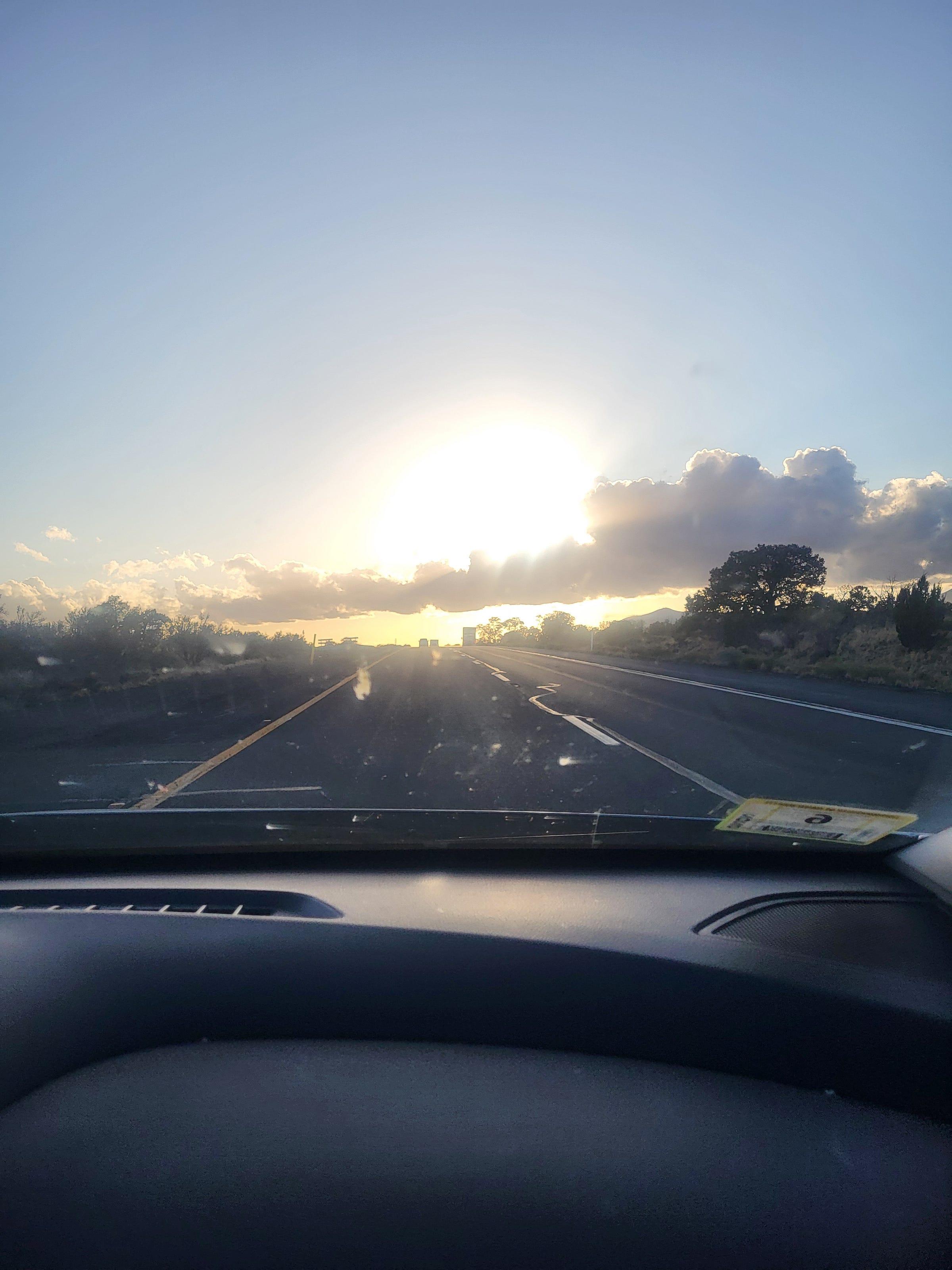
The Indian Reservations in that region are so depressing. I think you're seeing there what our future in 50 years could look like.
While I haven’t listened to it yet.. I will tell you that yes I am familiar with these songs.
It’s a great compilation and I will listen to it of course.
My Dad took me to see The Highwaymen in the late 80’s.
It was the first concert I went to.
Good memories.
An interesting read, too,
on many levels.
Some of which are personal.